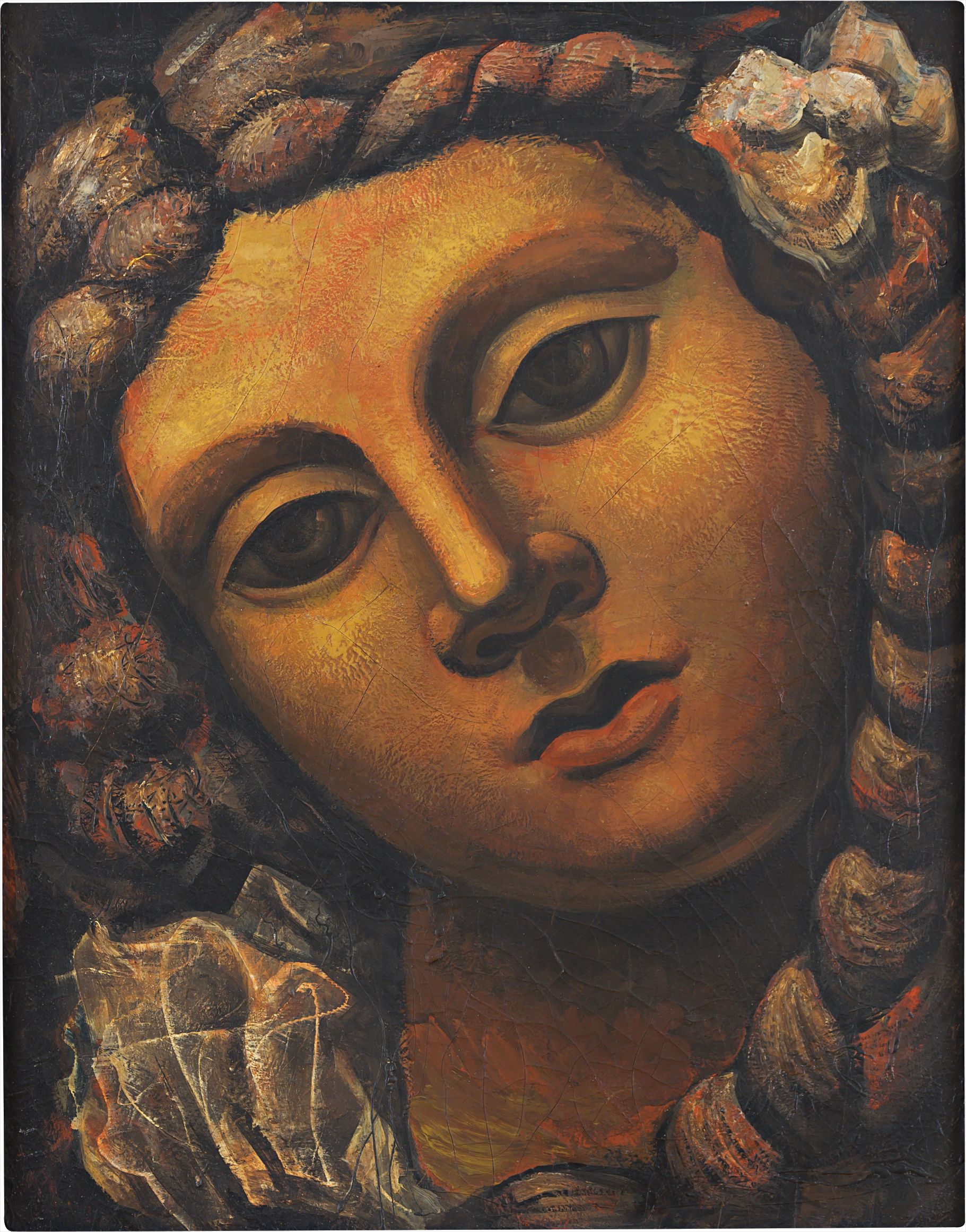

29
Mario Carreño
Cabeza (Face of a Woman)
Full-Cataloguing
First, art critic José Gómez Sicre, in his monograph Carreño (1943), referring to the painter and his work, which he knew very well, selected and reproduced this work under the title Cabeza (Head). Therefore it is reasonable to assume that this was the original title. Second, this painting registers the climax of a change, defining a turning point in the artist's career. It marks a shift in the way he understood and created his art. But how did this change come along for this painting?
By 1936, a young Carreño came to a revolutionary Mexico, during the heyday of the mural movement, where he intended to mature his art, aligning it with his political sentiments. His art during this period was characterized by socially conscious drawings, featuring workers in full fatigues with scaffolding, machinery and cane cutters. His works were composed of angular lines, fragmented and overlapping, in a game of futuristic and geometric tendencies that, since 1929, he signed with a combative ‘K’ for ‘Karreño’. In Mexico, he encountered the Dominican painter Jaime Colson, an experienced 35 year old artist formerly closely aligned with the Spanish and Parisian avant-garde. Now, at the height of muralism in the country, he was working as an artist and teacher. Colson was a lover of classical art and Carreño became his most attentive and hardworking pupil.
Colson was to Carreño the "sole master of maturity that guided his steps to fully dedicating himself to painting...insistently drinking in all the most remote Occidental sources" (Sicre, 1943). During those months in Mexico, Carreño learned the techniques of the muralists, a complete understanding of duco as a material and the classical order of painting. After Mexico, Carreño and Colson returned to Havana, and then continued on to Paris, keeping the spirit of this pedagogical relationship.
The present lot, although impossible to know whether painted in Mexico or Havana, was the result of this "diligent and persistent study…under Colson’s watchful discipline." It reveals the figure depicted as a quiet and timeless soul, demonstrating Carreño’s response to the repeated lessons of Colson. Only the classical style – the Dominican teacher insisted to his young Cuban student – gives the painting true beauty because classical style is the manifestation of eternal life immobilized in space. In this way, the present lot perpetuates the "intellectualized and enduring beauty of the Greco-Latin spirit” but also "golden and lustrous flesh, vitalized and eternalized in the infinite problem of beauty" (Sicre, 1943).
The present lot truly was the foundation for Carreño’s creation of successive important oil paintings, such as Desnudo (1937), La Toilette (1938) and Estudio para "Fresco" (1938). In fact, it is important to note, the similarities between the underlying Cabeza drawing and face of the female figure in Desnudo, Carreño’s first major canvas – still signed as Karreño – awarded in 1938.
Furthermore, the utilization of duco in the making of Cabeza foreshadows future duco works made by the painter six years later. These works feature compositions with a compressed foreground, lacking air or white spaces; the use of structural diagonal lines, generating a smooth motion in the preliminary drawing; layers of quick drying duco, suggesting a rapid painting process with an irregular surface that generates coarse texture; the controlled use of accident during the drying process; and the transparency of colors, ultimately creating a very delicate expressionism.
Certainly, in any Carreño retrospective, we can imagine Cabeza as an essential key, a testimonial jewel, that closes one door and opens another between two fruitful periods of his career: the end of a young illustrator and graphic designer committed to political art and the rise of a mature painter committed to the classical and timeless order of Western painting.
José Ramón Alonso Lorea
Art Historian and Researcher
Author, Coordinator and Editor of EstudiosCulturales2003.es
Mario Carreño
Cuban | B. 1913 D. 1999Throughout his career, Mario Carreño produced a large body of diverse work ranging in style from Neo-Classical Figuration to Abstraction, and he is widely recognized as a key figure in Modern Cuban art. Carreño spent his formative years abroad, visiting Mexico in 1935 and later traveling throughout Europe in the 1940s. While in Europe, Carreño drew great inspiration from such contemporary avant-garde styles as Expressionism, Cubism and Abstraction.
Like Amelia Peláez, Carlos Enrique and other second-generation Vanguardia artists, Carreño aimed to incorporate European Modernist style into his oeuvre while developing a nationalist visual lexicon. His seminal works from the '40s, including Fuego en el Batey, Corte de Caña and Danza Afrocubana are brilliantly colored Duco works that each represent an essential element of Cuban identity.